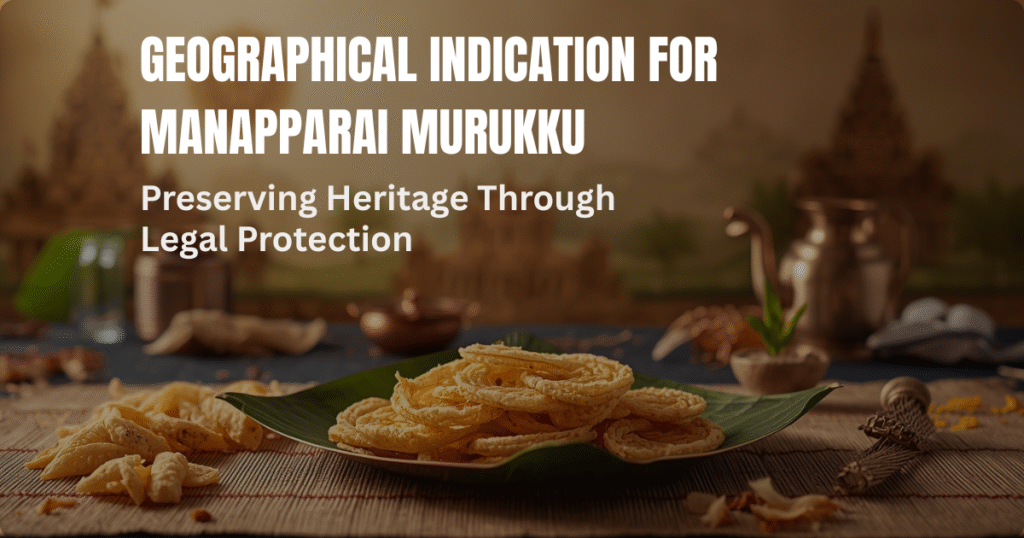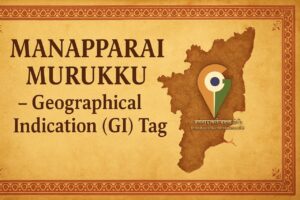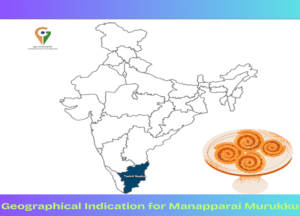
In a country as diverse and culturally rich as India, protecting traditional products is not just about intellectual property, but also about preserving identity and heritage. One of the most effective tools for this is the Geographical Indication (GI) tag, a form of recognition that links products to their place of origin and ensures authenticity, quality, and legacy.
A recent milestone in this domain is the official GI logo launch for Manapparai Murukku, a crunchy rice-based snack rooted in the small town of Manapparai in Tamil Nadu. This is more than a branding initiative; it marks a turning point for local producers, empowering them with legal backing, commercial potential, and cultural validation.
What Is a Geographical Indication (GI)?

A Geographical Indication is a designation used on products that have a specific geographical origin and possess qualities or a reputation that are essentially due to that location. In India, GI tags are governed by the:
- Geographical Indications of Goods (Registration and Protection) Act, 1999
- Geographical Indications of Goods (Registration and Protection) Rules, 2002
The Act provides a comprehensive legal framework for:
- Registration of GI products
- Legal protection of the registered GIs
- Prohibition of unauthorized use
- Rights of authorized users
The GI tag helps:
- Prevent unauthorized use by third parties
- Encourage regional economic development
- Safeguard traditional knowledge and practices
Statutory Framework: How and Where is a GI Filed?

Relevant Sections of the GI Act, 1999:
- Section 11 – Application for Registration: Any association of persons, producers, or any organization or authority established by or under law, representing the interests of producers, may apply for GI registration.
- Section 9 – Prohibition of Registration: Lists what cannot be registered, such as generic names, misleading marks, or content that offends public order or morality.
- Section 13 – Registration and Certificate: Upon acceptance and lack of opposition, the Registrar enters the GI into the register and issues a GI registration certificate.
- Sections 17 & 18 – Authorized Users: Individual producers can apply to become authorized users under a registered GI. This grants them the legal right to use the GI tag on their products.
Filing Authority:
Applications must be filed with the:
Geographical Indications Registry, Office of the Controller General of Patents, Designs and Trademarks, Chennai, Tamil Nadu, the only GI registry office in India.
How Is a Mark Assessed for GI Certification?
The process for granting a GI tag involves a rigorous legal and technical assessment by the Geographical Indications Registry, which operates under the Controller General of Patents, Designs & Trademarks. The key steps include:
● Application Filing
An association of producers or a statutory body must file an application, clearly detailing:
- The geographical boundaries of the area
- The history, origin, and uniqueness of the product
- Scientific, cultural, or economic evidence supporting the claim
● Examination
The Registry examines:
- Whether the product’s characteristics are attributable to its geographical origin
- If there is historic or traditional usage in the specified area
- Evidence of reputation or quality consistency
● Expert Review and Publication
If the application passes initial scrutiny, it is published in the GI Journal. This allows for public objections, if any.
● Opposition & Hearing (If Required)
If objections are filed, a hearing is conducted. Both parties may present their claims with supporting documentation.
● Final Registration
Once all criteria are met and no valid objections remain, the product is officially registered as a GI and can legally carry the GI tag.
In the case of Manapparai Murukku, the association provided compelling documentation of its traditional preparation method, the influence of local water, and its historical link to the Manapparai railway station, all of which were crucial in securing the certification.
The Journey of Manapparai Murukku
● Origin and Legacy
The story of Manapparai Murukku dates back to the 1920s, when it was first sold at the Manapparai railway station. Known for its distinct crunch, spiral shape, and mild spicing, the snack quickly gained popularity across Tamil Nadu and beyond.
Local lore attributes its unique taste to the mineral content in Manapparai’s water and a hand-rolled technique passed down through generations. Over time, the murukku evolved from a cottage snack to a regional brand—but not without challenges.
● GI Certification Timeline
2014: Application filed by the Manapparai Murukku Producers and Sellers Association
2023: GI tag granted by the Government of India
2025: Official GI logo launched by the Sulochana Panneerselvam Intellectual Property Rights and Rural Development Centre, Thanjavur.
This made Manapparai Murukku the first GI-tagged product from Trichy district, highlighting its unique cultural and economic value.
Why the GI Tag Matters?
● Legal Protection
Only registered members of the local producers’ association can now use the GI logo, which means imitators or counterfeiters can be legally challenged.
● Economic Empowerment
Over 500 families in and around Manapparai depend on murukku production. The GI tag enhances market recognition, allowing local artisans to command better prices and expand to national and international markets.
● Cultural Recognition
The GI tag is not just a commercial stamp, it is a badge of authenticity affirming that a humble snack from a small town holds a place in India’s culinary and cultural fabric.
Challenges Ahead
Despite the recognition, hurdles remain:
- Low awareness among producers about GI rights and benefits
- Limited branding and packaging infrastructure
- Short shelf life, which affects broader marketability
- Need for training in food safety and modern techniques without compromising on tradition
- These issues highlight the need for government support, capacity-building workshops, and market access initiatives.
What Can Be Done?
To fully leverage the GI tag, stakeholders must act collectively:
- Government: Provide subsidies for packaging, processing units, and export facilitation
- Associations: Educate members on quality control, trademark protection, and pricing strategies
- Consumers: Support authentic GI products by choosing certified goods
- Academia & NGOs: Conduct research and awareness drives on traditional foods and their protection
Conclusion
The Geographical Indication for Manapparai Murukku is a powerful example of how traditional knowledge, community effort, and legal frameworks can come together to preserve India’s rich culinary heritage.
As India continues to globalize, GI tags can ensure that local identities are not lost but celebrated, and that rural economies are not sidelined but supported. The story of Manapparai Murukku is more than just about a snack; it’s about honouring history, empowering artisans, and protecting what makes us unique.
Authored by,
Mr.Ananthakesavan V
(Associate Advocate – IPR and Litigation)
